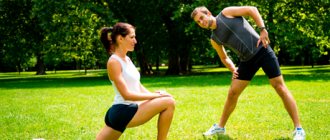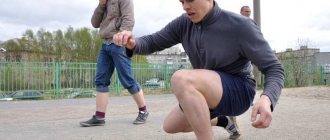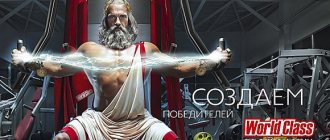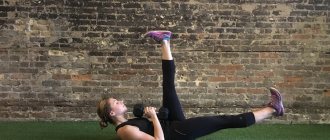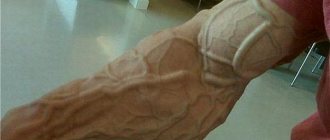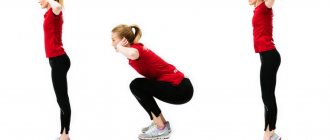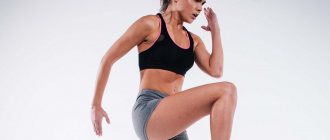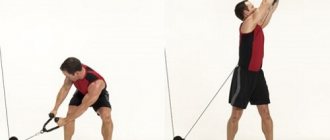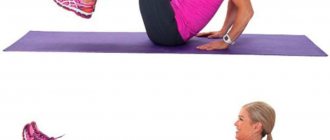For anyone who walks to lose weight or runs, it is important to know how wide he is walking. This will help you calculate the daily physical activity required to maintain muscle tone. To determine the parameter, physiologists and trainers have developed special formulas. You can also take the average or determine the number empirically.
Why measure your stride length?
This value is important for planning and monitoring the load, safety and effectiveness of classes:
- You need to load your walking parameters into the pedometer program to determine the distance traveled. Then the distance will be calculated as accurately as possible.
- To maintain running technique, athletes need to monitor the size of their stroke. It should be the same at any speed. The pace is increased by increasing the frequency of movements.
- To practice on an ellipsoid, you need to choose a model with a suitable amplitude. An elliptical trainer that is too short or long can cause joint pain and injury.
- For some treadmills, it is also necessary to enter this parameter into the training program.
- The indicator will help calculate the distance that should be walked daily in order to burn the calories received per day.
PRO
When they talk about professionals, amateur runners try to structure and adopt their technique, talking about its obvious effectiveness. However, in fact, in modern training the main priority is the individual characteristics of the athlete.
Of course, there are basic, basic principles, and the staging of movements, and everything else, but this is not used to radically change the biomechanics, but only for its slight adjustments and additions. An experienced eye can easily notice how different the technique is among the elite.
The same applies to step frequency along with length. At races, pros run differently: some focus on cadence, and others on frequency. But, be that as it may, the basic principle remains the same and both parameters increase to increase the pace, which is especially noticeable in the finishing sprint.
Step length at different speeds
The magnitude depends on whether the person is running or walking. The nature of the terrain (downhill or uphill), additional load, and weather conditions also influences.
The average step length of an adult depending on the method of movement:
- The longest stroke is for a running sprinter. The stride length when running is approximately 105–115 cm. This value should remain constant regardless of how a person runs: easy, medium, sprinting or jogging. The change in speed should occur solely by increasing or decreasing the frequency of movements.
- When walking, the stroke is shorter than when running - 70–80 cm. Regardless of the pace of movement (walking, recreational or sports), this parameter should not change. Trying to step wider to increase speed can lead to ligament inflammation and joint problems.
When running a marathon, the athlete's stroke size is 140–165 cm.
View this post on Instagram
A post shared by Veronica (@chiquita.tesoro) on Sep 22, 2014 at 8:45pm PDT
How to determine the speed of running, walking and distance traveled?
Walking and running are divided into several types depending on the dynamics and pace.
For example, walking is of the following types:
- walking;
- with an average pace;
- health;
- sports.
The first walking option resembles a walk. It has a low speed, short stride and a slow tempo. In this case, a person takes about 50-70 steps per minute at a speed of 4 km/h. The pulse rate is approximately 70 beats per minute. Since there is no physical activity during walking, this type of walking is not considered healthy.
Moving at a medium pace implies a wide gait. A person takes 70-90 steps per minute at an approximate speed of 4-6 km/h.
A higher pace is typical for recreational walking. At the same time, the speed reaches 7 km/h, and the number of steps per minute is 70-120. During movement, your heart rate increases, which improves blood circulation.
When race walking, which has a certain technique, a person strives to achieve great speed, but at the same time he should not run. Also, the flight phase is not allowed, and one foot is supported on the surface. A professional is able to move at a speed of 16 km/h, his pulse increases to 180 beats per minute. Race walking is considered beneficial for your figure.
The distance traveled by a person in a day depends on his lifestyle. This is usually related to the type of activity, such as sedentary or dynamic work. According to doctors' recommendations, a pedestrian needs to take 10,000 steps a day.
When a person runs, the capillaries are filled with blood, which helps improve the body's condition. Depending on the distance, running can be on the spot or it involves covering short, medium and long distances.
Running in place is less effective than running. It is suitable for any conditions, so you don’t need a stadium to move around, you can confine yourself to a small space.
You don't need a certain amount of endurance to run short distances. The essence is the runner's dedication to quickly reach the finish line.
The average distance ranges from 600 meters to 3 km. The pace of movement should be slightly above average.
The long distance is from 2 miles to 42 km. Jogging is appropriate here.
Depending on the speed, running is divided into types:
- easy;
- with an average pace;
- jogging;
- sprint
Light running resembles walking. In this case, the movement speed is about 5-6 km/h. This kind of running is useful for those who are overweight and for older people.
The average pace is suitable for morning runs. The speed is 7-8 km/h.
Jogging is used for medium and long distances; it has a beneficial effect on the health of the body.
Sprinting achieves maximum speed and is suitable for short distances of approximately 200 metres.
The easiest way to find out your walking or running speed is to use a treadmill.
Another option for determining speed is arithmetic calculations. Having measured the length of the desired section, you should note the time of movement from one point to another. For example, a person ran a distance equal to 300 m in 3 minutes. You need to divide 300 by 3, you get the distance covered in a minute equal to 100 m. Next, 100 m * 60 minutes = 6000 m. This means that the person’s speed is 6 km / h.
Methods for calculating stride length
Knowing the height, you can use several formulas to determine the value. For running and walking disciplines, different calculation methods are used:
- the size of a running person's stroke = height in cm x 0.65;
- step size of a walking person = height in cm/4 + 37;
- for women - height in cm x 0.413;
- for men - height in cm x 0.415.
Useful video on the topic:
Other methods:
- You can use an online human step length calculator. You must enter your height in cm. This method is only suitable for people with an average build and weight.
- "Wet trace" method. Walk at a normal pace on wet sand or in wet shoes on asphalt. After this, you need to use a tape measure to measure the distance from the heel of the footprint left by one foot to the heel of the footprint of the other. You can also navigate by the toes of the tracks. Add up all the resulting values and divide by their number.
- Measure 10 meters and walk the distance. Divide 10 by the number of movements. This will allow you to determine how many steps there are in 1 meter.
- On a small soccer field, walk from the goal line to the others. This distance is 91.4 m. Divide this number by the number of moves made.
Speed
For competitive marathon runners, this is the main reason for the whole idea of exploring the possibilities and optimizing the work of their own biomechanical complex.
Running speed = stride length x cadence .
This simple equation captures the essence of running. In order to run faster, we need to increase either the cadence or the distance from one landing point to another. Or better yet, both.
Professional athletes run with the highest possible frequency and stride length. However, they are in a balanced ratio and do not exceed the body’s ability to maintain a given pace for a long time. That is why the cadence of the elite does not fall below 180 steps per minute, but rarely exceeds 210 steps/min.
Not because specialists in biomechanics and sports physiology decided so, but because an organism prepared by training (especially the cardiovascular system) can work with such numbers, reaching maximum speed and maintaining it for a long time.
Some running theories, such as chi running, claim that to increase your pace you only need to increase your stride length while keeping your stride frequency constant. These theories are at odds with the practice and opinion of most top athletes, who say that the most optimal and effective option is to increase both parameters.
How to check your stride length empirically
The value obtained from the formula can be checked:
- Knowing the exact distance between two points on the ground, it is enough to walk or run this distance at a normal pace, while simultaneously counting the number of moves made. The distance covered must be divided by the last indicator. The distance must be at least 50–100 meters so that the number can be determined with an accuracy of 1 cm.
- Having an iPhone with a pedometer at hand, you can choose the appropriate route in the city and walk it. The application will show the mileage traveled. Kilometers must be converted to cm and divided by the number of moves made.
Interesting video on the topic:
How to Master Running Technique
The first thing you should pay attention to when mastering the correct running stride is working on strengthening the muscles of the whole body. When running, not only strong legs are important, well-developed back muscles also play a special role, because a slouched runner will not achieve good results. It is also important to work on improving your coordination.
Next, we move on to practicing the technique itself. For example, all kinds of exercises and running with a skipping rope will help you master the correct position of the foot when running. We should not forget about exercises such as running with your back, hip raises, cross steps, jumping on your toes, various lunges, etc. These are all special exercises for mastering running technique.
Having mastered the running step, you can begin training the full running cycle. You shouldn’t start with long distances right away; training shouldn’t be exhausting. Start with a medium-distance run - no more than 2 kilometers. While running, concentrate directly on technique, pay attention to mistakes, and correct them. Remember that the first runs are not about the duration, but about the correct running cycle.
Later, you can concentrate on other elements and try more complex types like interval running.
It is important to remember that the load must be dosed. Do not overload yourself with excessive volumes, after which you will not want to repeat classes. Pay attention to the quality of movements. The results will please you - running will become easy, economical and enjoyable. Have a good workout.
How to correctly measure your physical parameters to select the frame size
In this article, we will try to guide you through a system for calculating the size of the frame and other components according to your height, the size of your arms, legs, etc. The system was developed by Competitive Cyclist.
In order to select the size of all components you will need time, an assistant, a ruler, meter, level, pen and paper.
STEP 1: Select the type of bike
Different types of bicycles have their own frame size scales, characteristic fit and other features. Choose the right type of bike for the type of riding you want.
Follow the link: https://www.competitivecyclist.com/Store/catalog/fitCalculatorBike.jsp#type.
The following selection is made in the illustration: man, road bike, body measurements will be in centimeters.
After making your selection, press the CONTINUE button and go to the next page.
STEP 2: Take measurements and fill out the form
You need to measure the following measurements in centimeters, look in order (click on the photo and see the description under the photo). On the website, you can also watch a video, but it’s better to read the description of the photo.
Inseam - Measure the length from the floor to the groin line Torso length - Measure the length of the torso from the chair line to the line from the hump on the shoulder Forearm length - Length from the center of the axis of the tube in the hand (hold the saddle) to the hump on the forearm Arm length - Length from the center of the axis object in hand to the hump on the arm in the area of the collarbone length of the thigh - Sit upright. The pelvis touches the wall. Measure the length from the wall to the knee line. Shin length - Length from the floor to the line of the top edge of the kneecap. Measure 2 values and take the average. growth to the pectoral notch - Locate the notch under the Adam's apple, the beginning of the sternum. Measure your height from this point to the floor. Overall height - Place the book on your head parallel to the floor and make a mark on the wall. Measure the length from the mark to the floor. When measuring, keep your legs apart, at an angle of 30 degrees.
Fill in the values in the table and press CONTINUE.
STEP 3: Receive, interpret and store values
On this page you will see frame sizes, stem sizes and other settings that can help you customize the fit on your bike.
Below, you can either change the values (go back) or send the results to yourself by email.
Good luck with your measurements and choosing the frame size and stem length.
www.everyvelo.com
Measuring a path in steps - Without a measuring stick - Fun tasks and experiments
A measuring ruler or tape is not always at hand, and it is useful to be able to somehow manage without them, making at least approximate measurements.
The easiest way to measure more or less long distances, for example during excursions, is to take steps. To do this, you need to know the length of your step and be able to count steps. Of course, they are not always the same: we can take small steps, or we can take big steps if we wish. But still, during normal walking, we take steps of approximately the same length, and if you know their average length, then you can measure distances in steps without much error.
To find out the length of your average step, you need to measure the length of many steps together and calculate the length of one from there. In this case, of course, you can no longer do without a measuring tape or cord.
Pull the tape out on level ground and measure a distance of 20 m. Draw this line on the ground and remove the tape. Now walk along the line at a normal pace and count the number of steps you take. It is possible that the step will not fit an integer number of times over the measured length. Then, if the remainder is shorter than half the length of the step, it can simply be folded back; if it is longer than half a step, the remainder is counted as a whole step. Dividing the total length of 20 m by the number of steps, we get the average length of one step. This number must be remembered so that, if necessary, it can be used for measurements.
In order not to get lost when counting steps, you can - especially over long distances - count as follows. Count steps only up to 10; Having counted to this number, bend one finger of the left hand. When all the fingers of the left hand are bent, that is, 50 steps have been taken, one finger on the right hand is bent. So you can count up to 250, after which they start again, remembering how many times all the fingers of the right hand were bent. If, for example, after walking a certain distance, you bend all the fingers of your right hand twice and by the end of the journey you have three fingers bent on your right hand and four on your left, then you have taken steps
2 X 250 + 3 X 50 + 4 X 10 = 690.
Here you need to add those few more steps that were taken after the finger of the left hand was bent for the last time.
Let us note in passing the following old rule: the length of the average step of an adult is equal to half the distance from the floor to the eyes.
Another old rule of thumb relates to walking speed: a person walks as many kilometers in an hour as the number of steps he takes in 3 seconds. It is easy to show that this rule is true only for a certain step length and, moreover, for a fairly large step. Indeed: let the step length be x m, and the number of steps in 3 seconds be n. Then in 3 seconds the pedestrian makes nx m, and in an hour (3600 seconds) - 1200 nx m, or 1.1 nx km. For this path to be equal to the number of steps taken in 3 seconds, there must be an equality:
1.2 nx = n, or 1.2 x = 1.
Where x = 0.83 m.
If the previous rule about the dependence of step length on a person’s height is true, then the second rule, now being considered, is justified only for people of average height - about 175 cm.
Live scale
To measure medium-sized objects, without having a meter ruler or tape at hand, you can do this. You need to pull a string or measure a stick from the end of your outstretched arm to the opposite shoulder (Fig. 319) - this is the approximate length of a meter for an adult man. Another way to get the approximate length of a meter is to plot in a straight line...
Measuring with coins Our modern copper (bronze) coins can also serve well. Not many people know that the diameter of a penny coin is exactly 1 1/2 cm, and a nickel is 2 1/2 cm, so that both coins placed side by side give 4 cm. This means that if you have several copper coins with you, then you you can be quite accurate...
www.poznovatelno.ru
running step
Running is an alternation of movements of the lower extremities with a predetermined cyclicity. This alternation is called a running step. The running step contains a push with one leg, a short flight, landing on the second leg, after which there should be a push-off with the leg given to us with a simultaneous swinging movement of the main one and the transition to repeating the cycle.
The running step at different distances differs in the frequency of the step, its length, the mechanics of the push leg, and the position of the body.
Running is an alternation of movements of the lower extremities with a predetermined cyclicity. This alternation is called a running step. The running step contains a push with one leg, a short flight, landing on the second leg, after which there must be a push-off with the leg given to us with a simultaneous swinging movement of the main one and the transition to repeating the cycle.
A running stride at various distances is determined by the frequency of the stride, its length, the mechanics of the jogging leg, and the position of the body.
Short-distance running has similar personalities and therefore the running stride of sprinters needs to be examined separately.
For medium and long distances, the main issue is good running technique, which allows the runner to save weight and at the same time maintain sufficient speed.
Running stride length
Let's start with the actually main, physiological component of the running stride length. Short jogging, if possible, is suitable for some runners, for example, those recovering from lower limb injuries or the elderly, but in general this is an unproductive way; the muscles act at a quarter of the mass, and the joints are quite limited in movement.
In addition, such mincing running leads to the early development of lethargy, provokes phlebitis, and inflammatory processes in the ligamentous-articular apparatus.
A very high step is very exhausting for the runner, disrupts the ergonomics of movements, and has a destructive effect on the spine. This kind of running is inspired by kangaroo jumps; muscles and joints do not act cyclically, but in a flurry mode, sometimes a sudden overload is replaced by a more abrupt stop of the activity (the reason for the flight).
Advice!
The labyrinth of the middle ear of an inhabitant of our planet, responsible for coordination, is not adapted to this type of movement (thirsty and gnawing potential to train it), and therefore the coordination of movements during an extensive step, one way or another, is disrupted.
Step length is personal. On average, the best step can be calculated based on an approximate length of 65% of the athlete’s height. In other words, for an inhabitant of our planet 165 centimes tall. The length of the running stride varies around 105 centimeters. This length cannot be considered universally suitable for all athletes with a height of 165 centimeters.
But based on this figure, using an experimental method you can find the closest best length. Sometimes the running step begins and the running becomes fluent, smooth, not exhausting and does not require constant control over the position of the limbs and body.
Running stride frequency
The frequency of the step directly depends on its length. It is necessary to run in such a way that during the running there are no delays or, on the contrary, acceleration of the step.
The change of movements must be smooth, otherwise it is inevitable that you will either bump into the leg in front, which can lead to overloading the joints of the lower extremities and a fall, or very early removal of the leg followed by braking and bringing the body forward. The alternation of running phases should be smooth, without a visible transition from push to push.
Body position when running
The torso of a runner at long and medium distances must always be in an upright position, even when the start is high at these distances.
From time to time, inexperienced runners feel that tilting the body forward increases the streamlining of the body and gives an imaginary feeling of free running. In fact, this is not entirely true. Streamlining increases, that's right. But the acceleration acquired by this method is not decisive for running over long distances, but the risk of falling, bumping, failure of rhythm and cadence is extremely high.
In addition, with this position, the overload on the muscles of the neck and the middle part of the spinal column, as well as the foot, increases. If the body is thrown back, then the step becomes excessively high and energy-consuming.
When lowering the foot, the usual slapping sound is heard, and the risk of injury to the ankle joint and lower spine increases. One way or another, the wrong position of the body leads to unnecessary energy consumption.
Hand position and range of motion
And little about the position of the hands. The hands are responsible for helping the runner reduce the twisting of the body in the lumbar region and maintain balance. When running, the arms are bent at the elbows at an angle slightly less than 90 and spread to the sides horizontally by less than 40-45.
Light, relaxed movement of the arms, with an amplitude that does not exceed more than a third of the running step, helps maintain the running pace, maintain breathing and correct body biomechanics, and reduce the load on the legs and spine.
Source: https://soskidka.ru/vse-o-bege/begovoj-shag.html
